The Kakhovka dam’s failure could unleash 4.8 billion gallons of water and flood Kherson and dozens of other areas where hundreds of thousands of people live.
KYIV, Ukraine (AP) — The wall of a major dam in a part of southern Ukraine that Moscow controls collapsed Tuesday after a reported explosion, sending water gushing downriver and prompting dire warnings of ecological damage as officials from both sides in the war ordered residents to evacuate.
Ukraine accused Russian forces of blowing up the dam and hydroelectric power station, while Russian officials blamed Ukrainian military strikes in the contested area.
The fallout could have far-reaching consequences: flooding homes, streets and businesses downstream; depleting water levels upstream that help cool Europe’s largest nuclear power plant; and draining supplies of drinking water to the south in Crimea, which Russia illegally annexed.
The dam break added a stunning new dimension to Russia’s ongoing war in Ukraine, now in its 16th month. Ukrainian forces were widely seen to be moving forward with a long-anticipated counteroffensive in patches along more than 1,000 kilometers (621 miles) of frontline in the east and south of Ukraine.

It was not immediately clear whether either side benefits from the damage to the dam, since both Russian-controlled and Ukrainian-held lands are at risk of flooding. The damage could also potentially hinder Ukraine’s counteroffensive in the south, while at the same time Russia depends on the dam to supply water to the Crimea region it annexed illegally in 2014.
Amid official outrage, Ukrainian President Volodymyr Zelenskyy said he convened an urgent meeting of the National Security Council. He alleged that Russian forces set off a blast inside the dam structure at 2.50 a.m. (2350 GMT) and said some 80 settlements were in danger.
Ukraine’s nuclear operator Energoatom said in a Telegram statement that the damage to the dam “could have negative consequences” for the Zaporizhzhia Nuclear Power Plant, which is Europe’s biggest, but wrote that for now the situation is “controllable.”
The U.N.’s International Atomic Energy Agency said in a statement there was “no immediate risk to the safety of the plant,” which requires water for its cooling system.
It said that IAEA staff on site have been told the dam level is falling by 5 centimeters (2 inches) an hour. At that rate, the supply from the reservoir should last a few days, it said.
The plant also has alternative sources of water, including a large cooling pond than can provide water “for some months,” the statement said.
Ukrainian authorities have previously warned that the dam’s failure could unleash 18 million cubic meters (4.8 billion gallons) of water and flood Kherson and dozens of other areas where hundreds of thousands of people live.
The World Data Center for Geoinformatics and Sustainable Development, a Ukrainian nongovernmental organization, estimated that nearly 100 villages and towns would be flooded. It also reckoned that the water level would start dropping only after five-seven days.
A total collapse in the dam would wash away much of the broad river’s left bank, according to the Ukraine War Environmental Consequences Working Group, an organization of environmental activists and experts documenting the war’s environmental effects.
Mykhailo Podolyak, a senior adviser to President Volodymyr Zelenskyy, said that “a global ecological disaster is playing out now, online, and thousands of animals and ecosystems will be destroyed in the next few hours.”
Videos posted online began testifying to the spillover. One showed floodwaters inundating a long roadway; another showed a beaver scurrying for high ground from rising waters.

The Ukrainian Interior Ministry called for residents of 10 villages on the Dnipro’s right bank and parts of the city of Kherson downriver to gather essential documents and pets, turn off appliances, and leave, while cautioning against possible disinformation.
The Russian-installed mayor of occupied Nova Kakhovka, Vladimir Leontyev, said it was being evacuated as water poured into the city.
Ukraine controls five of the six dams along the Dnipro, which runs from its northern border with Belarus down to the Black Sea and is crucial for the entire country’s drinking water and power supply.
Oleksandr Prokudin, the head of the Kherson Regional Military Administration, said in a video posted to Telegram shortly before 7 a.m. that “the Russian army has committed yet another act of terror,” and warned that water will reach “critical levels” within five hours.
Ukraine’s state hydro power generating company wrote in a statement that “The station cannot be restored.” Ukrhydroenergo also claimed that Russia blew up the station from inside the engine room.
Leontyev, the Russian-appointed mayor, said Tuesday that numerous Ukrainian strikes on the Kakhovka hydroelectric plant destroyed its valves, and “water from the Kakhovka reservoir began to uncontrollably flow downstream.” Leontyev added that damage to the station was beyond repair, and it would have to be rebuilt.
Ukraine and Russia have previously accused each other of targeting the dam with attacks, and last October Zelenskyy predicted that Russia would destroy the dam in order to cause a flood.
Authorities, experts and residents have for months expressed concerns about water flows through — and over — the Kakhovka dam.
In February, water levels were so low that many feared a meltdown at the Zaporizhzhia nuclear plant, whose cooling systems are supplied with water from the Kakhovka reservoir held up by the dam.
By mid-May, after heavy rains and snow melt, water levels rose beyond normal levels, flooding nearby villages. Satellite images showed water washing over damaged sluice gates.
Credit: Source link